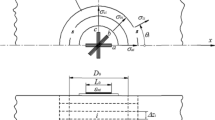Abstract
A methodical approach to estimating the accuracy of the stressed-deformed state of structural elements has been presented that consists of the reverse analysis of errors in analytical and numerical solutions. The novelty of the approach lies in defining the problems of comparing analytical and numerical results jointly with the developed method for estimating the computational errors. The approach makes it possible to increase the validity of computation results according to the applied computation procedures, which makes it possible to increase the reliability and safety of technical objects.
Similar content being viewed by others
Change history
24 August 2018
The affiliation under the symbol ?b? should read: Institute of Computational Modeling, Siberian Branch of the Russian Academy of Sciences, Krasnoyarsk, 660036 Russia
References
Rogalev, A.N., Doronin, S.V., and Rogalev, A.A., The way to check-up the solution accuracy under analyzing stressed-deformed state of high-responsible technical objects, Sistemy. Metody. Tekhnol., 2015, no. 3, pp. 32–38.
Doronin, S.V. and Rogalev, A.N., The way to estimate computational mistake in the problem on stretching the plate with arch cut, Vestn. Mashinostr., 2015, no. 1, pp. 24–27.
Savin, G.N., Raspredelenie napryazhenii okolo otverstii (Stresses Distribution near Apertures), Kiev: Naukova dumka, 1968.
Tsilindricheskie obolochki, oslablennye otverstiyami (Cylindrical Shells Weaken by Apertures), Guz’, A.N., Ed., Kiev: Naukova dumka, 1975.
Gol’denveizer, A.L., Teoriya uprugikh tonkikh obolochek (The Theory of Elastic Thin Shells), Moscow: Nauka, 1976.
Sigova, E.M. and Doronin, S.V., Numerical parametrical analysis of stressed-deformed state of cylindrical shell with round cut, Vestn. Mashinostr., 2015, no. 4, pp. 13–16.
Crawford, J., Evaluating mesh density, ANSYS Solut., 1999, vol. 1, no.2.
Peterson, R.E., Stress-Concentration Factors, New York: Wiley, 1974.
Timoshenko, S.P. and Voinovskii-Kriger, S., Plastiny i obolochki (Plates and Shells), Moscow: Nauka, 1963.
Author information
Authors and Affiliations
Corresponding author
Additional information
Original Russian Text © S.V. Doronin, A.N. Rogalev, E.M. Reizmunt, 2017, published in Problemy Mashinostroeniya i Nadezhnosti Mashin, 2017, No. 4, pp. 54–59.
About this article
Cite this article
Doronin, S.V., Rogalev, A.N. & Reizmunt, E.M. Problems on comparing analytical and numerical estimations of stressed-deformed state of structure elements. J. Mach. Manuf. Reliab. 46, 364–369 (2017). https://doi.org/10.3103/S1052618817040069
Received:
Published:
Issue Date:
DOI: https://doi.org/10.3103/S1052618817040069



